 The capital “F” in a circle is a symbol only rarely encountered on the Bute Inlet Geology map (National Topographic System reference 92 K). One can be found adorning the southern end of the Twin Islands, which are tucked in close to the southeast coast of Cortes Island. Quite remarkable, really.
The capital “F” in a circle is a symbol only rarely encountered on the Bute Inlet Geology map (National Topographic System reference 92 K). One can be found adorning the southern end of the Twin Islands, which are tucked in close to the southeast coast of Cortes Island. Quite remarkable, really.
The literature accompanying the map has this enigmatic remark to offer:
“At Iron Point, the southeastern extremity of the Twin Islands, Bancroft [1913] observed … limestone alternating with argillite and quartzite … The Late Triassic age of these strata was confirmed by a poorly preserved valve interpreted as Pseudomonotis subcircularis.” – Hans Trettin, 2002 and 2012
One poorly preserved valve of the Late Triassic index fossil, the so-called paper clam Monotis subcircularis (the species has recently been restored to its original genus, Monotis) – is pretty much all the encircled “F” on the map signified, all these years since 1913!

Then, circa 2005, Barry Saxifrage picked up a small rock fragment (Fig.1) with what definitely qualifies as “a poorly preserved valve” imprint, looking more like a series of scratch marks than a fossil. But the lines are arranged at the appropriate angles, and their profile is not random, but an alternation of rounded ridges and sharply incised valleys: definitely the remnants of a bivalve shell like Monotis. This singular and unlikely find would remain as the only concrete evidence in hand, teasing us with its suggestive presence for years to come.…
[divider]
Hydrozoan Fossil
In the meantime, a number of visits to Iron Point (the area encircled by the “F” on the map above) produced other observations of interest. Among the clearly stratified and sometimes folded and tilted strata of sedimentary rocks (Fig. 2) were areas containing odd “blobs,” some weathered in peculiar ways (Figs. 3 and 4).

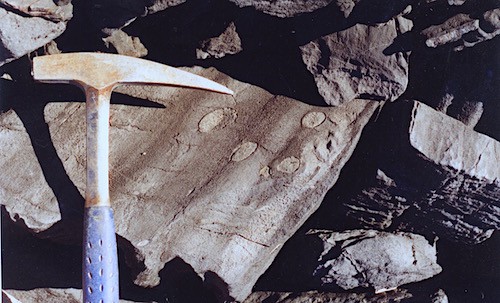

On the strength of a couple of not particularly well-preserved specimens like this, Jim Haggart – senior palaeontologist at the Geological Survey of Canada (GSC) – ventured an identification of these “blobs” as the somewhat enigmatic hydrozoan fossil Heterastridium sp.
The exact taxonomic status of this extinct creature is unclear, though its usefulness as an index fossil is unquestioned: it has only ever been observed in rocks of Late Triassic age – and the pale blue area on the geology map above signifies just that: Late Triassic Parson Bay Formation ca. 220 million years old.
Structural Rock Talk
The layered rocks of Iron Point and, indeed, all of South Twin Island, have been stressed, both tectonically and thermally. They tend to be dark, typical of oxygen-poor sediments, and contain abundant iron pyrite, which weathers rapidly to rust when exposed at the rock surfaces. The rust colour is conspicuous, and it has earned Iron Point its name.
The Parson Bay Formation has been broken up by numerous Andesite dykes, as well as by fairly massive granitic intrusions (Fig. 5) – not to mention the fact that it is in contact with the Granodiorite (gd on the map) of the Whaletown pluton (sensu Trettin). Varying degrees of metamorphism have altered the fossil content through recrystallization as well as mineral replacements, thereby obscuring most internal features and fine details (Figs. 6 and 7).
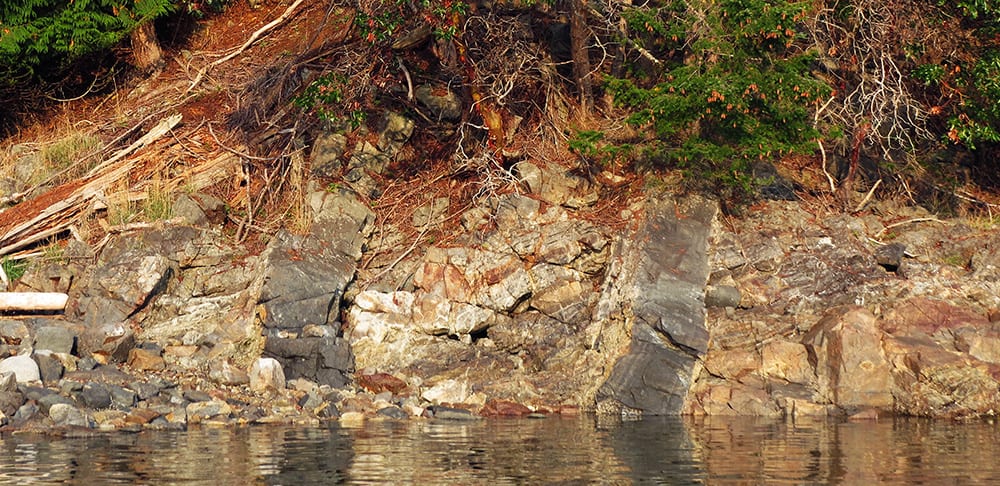
Hydrozoan Fossil Details
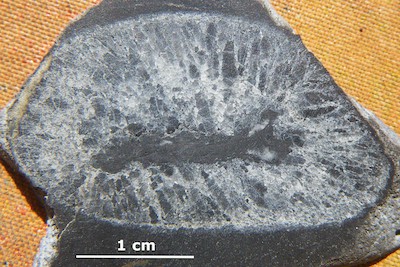

Heterastridium occurs in different lithologies: in the dark impure limestones as well as in siltstone, the latter sometimes strongly indurated (hardened) and sprinkled with iron pyrite clusters (called framboids, which translates as raspberries).
In some spots near Iron Point and in adjacent Echo Bay, Heterastridium forms dense aggregates (Fig. 8) which seems to be common in other locations worldwide, and, in the literature, it is interpreted as evidence for the pelagic (planktonic) lifestyle of the floating hydrozoan colonies.
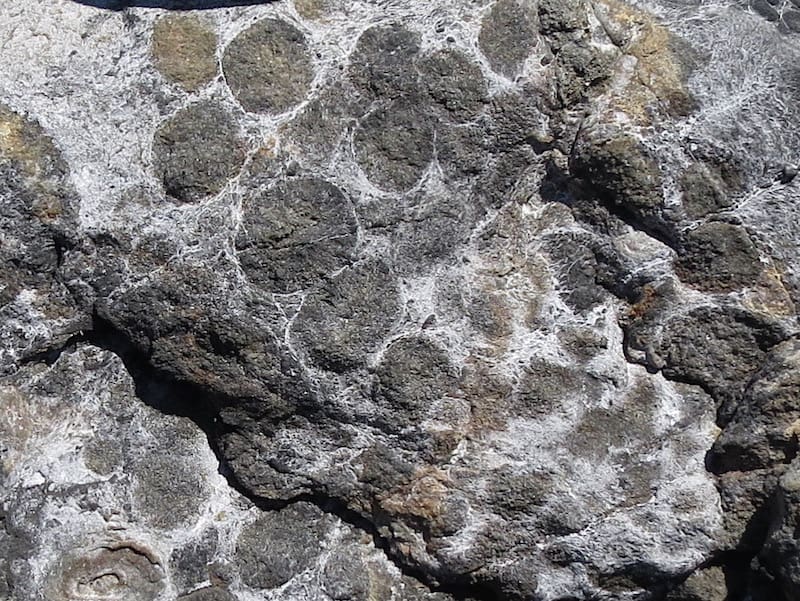
Wherever Heterastridium occurs in hardened siltstone, it is possible to dissolve the clacitic cores of the fossils and make the impressions of outer surfaces visible. Occasionally, the surface preserves great detail (Figs. 9 and 10), and it is possible to unequivocally endorse Jim Haggart’s assessment: indeed, the Iron Point and Echo Bay “blobs” are classic representations of Heterastridium sp.
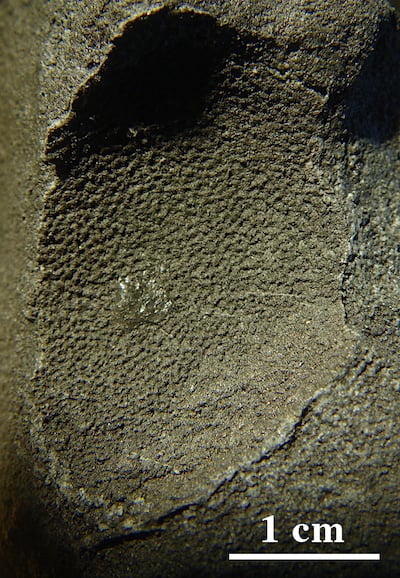

Compare Fig. 10 with this classic illustration from Karl Alfred von Zittel’s old (1910) textbook: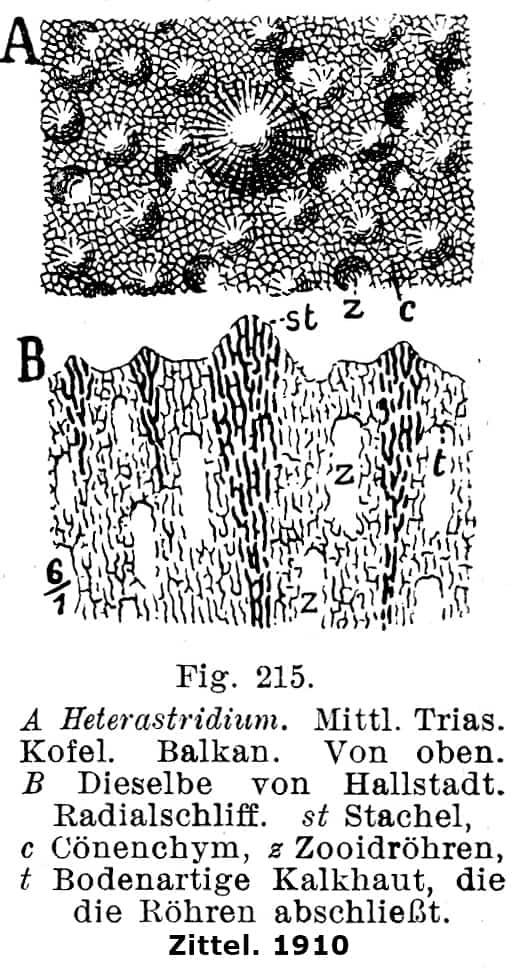
Fossil Bonanza
Expectations, kindled by Bancroft’s 1913 report and by Barry Saxifrage’s find of the enigmatic “poorly preserved bivalve shell,” led to further investigations of the area adjacent to Iron Point, known as Echo Bay, in hopes of finding further Late Triassic fossils, other than Heterastridium. During the summer of 2020, the author stumbled upon a prominently weathering rock layer (referred to by us as the Cardita Bed), with conspicuous surface markings (Fig. 11).

This is a hard and richly fossiliferous siltstone with many weathered-out hollows, some of them representing Heterastridium, others clearly caused by the dissolution of calcitic shell material, most of it fragmentary. Difficult material to work with. Occasionally, a beach cobble shows the external mold of a bivalve with distinct surface sculpture (Fig. 12).
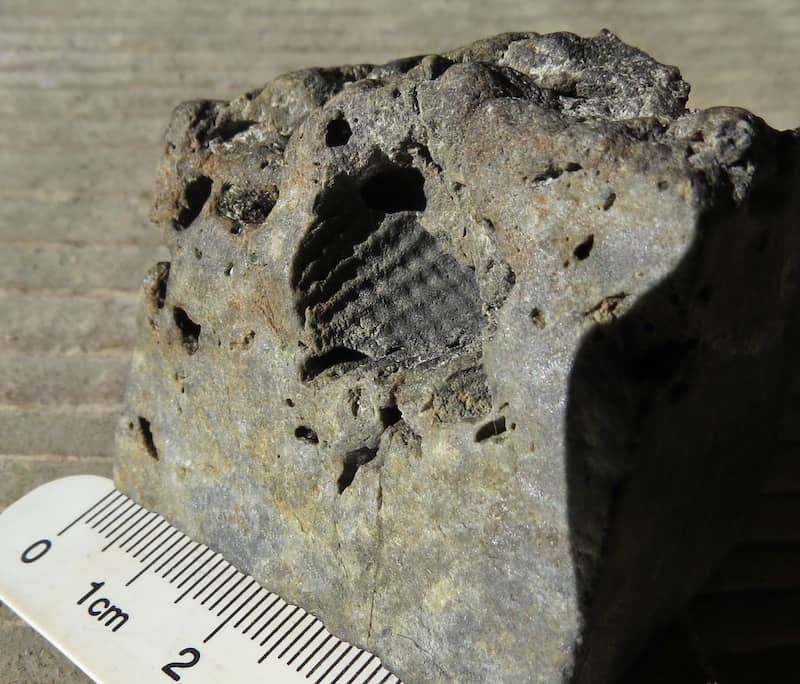
Ultimately, the most productive technique for retrieval and identification of fossil material from this outcrop turned out to be slicing and etching: cutting pieces off larger beach rocks and dissolving the shell content in diluted hydrochloric acid. Polishing sections, even to a high gloss, does not reveal enough useful detail, while the hollow molds left after acid treatment show detailed surface features that allow, if not always precise individual identification, the assessment of the fossil diversity this particular siltstone bed contains.
The following images (Figs. 13 to 18) are meant to convey an impression of this:
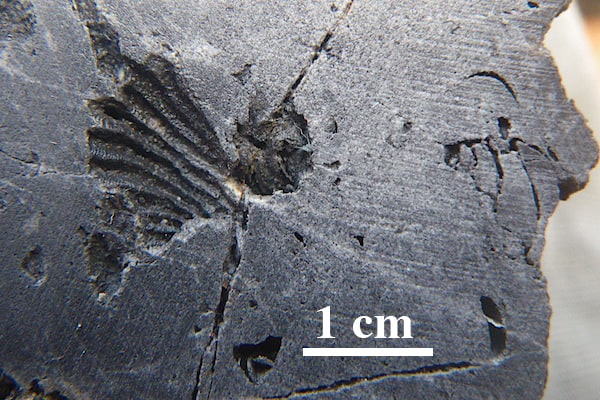
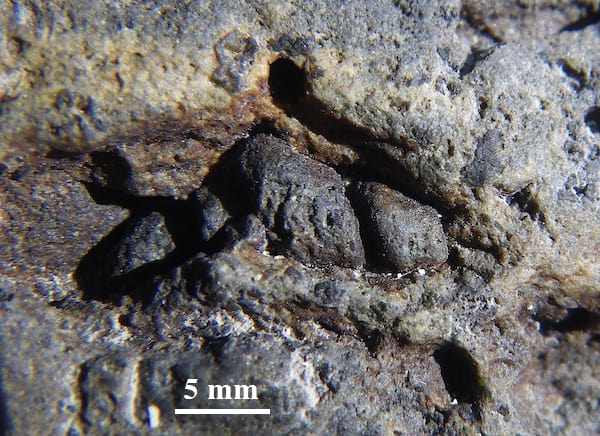
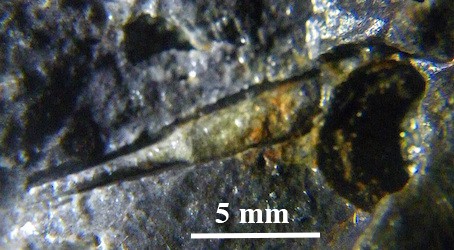
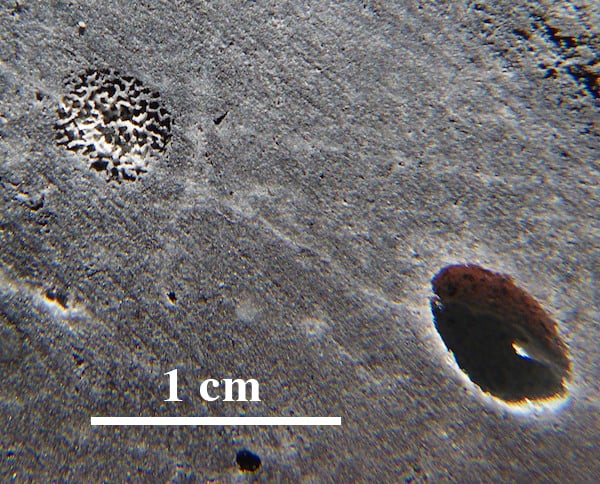

After the massive extinction event at the end of the Permian era, the great Late Palaeozoic coral reefs were all gone, and it fell to the Middle and Late Triassic to start rebuilding a rich coral biodiversity. Many of the resulting groups managed to survive the End-Cretaceous asteroid impact and became the basis for the spectacular reefs modern oceans boasted – until quite recently, that is.
Numerous fossil remnants of corals occur in the Cardita Bed, occasionally preserved in minute and exquisite detail, as the image occupying the right half of Fig. 18 demonstrates.
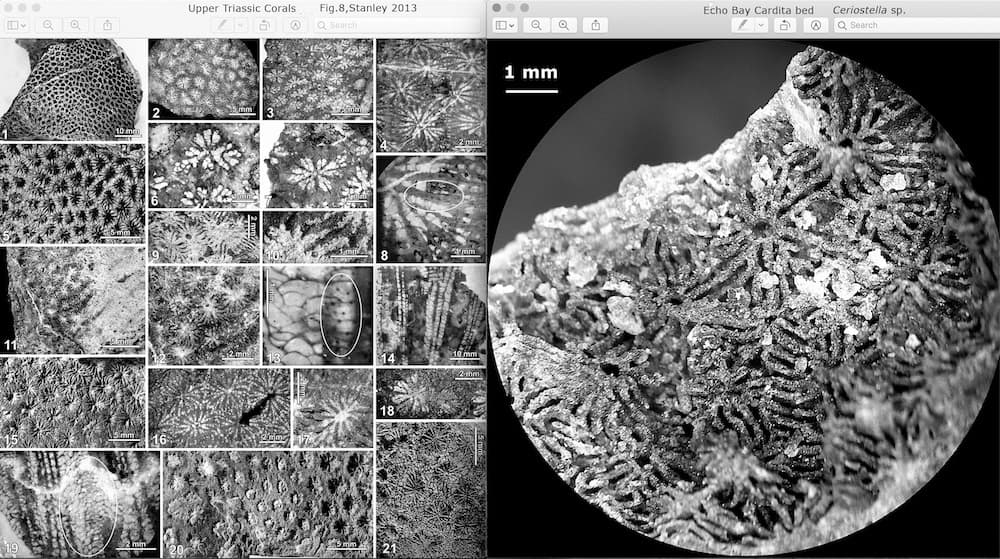
Monotis, THE Index Fossil
Discovering the Cardita Bed with its high diversity of fossils was certainly an exciting highlight of our exploration of the Parson Bay Formation on South Twin Island. Still, at the back of our minds, a sense of incompleteness and mild frustration lingered: the one fossil that had put the “F” on the local geology map, the paper clam Monotis subcircularis, kept eluding us. Barry Saxifrage’s specimen (Fig. 1) was not much more than a tease, a niggling reminder of what could and should be in the sedimentary rocks of Iron Point and Echo Bay.
Then, on 29 September 2020, our usual team (Barry & Carrie Saxifrage, my wife Aileen Douglas and I, Christian Gronau) were on location once again, and after what seemed like not a very long time of looking around, Aileen pulled a small rock fragment from the beach rubble (Fig. 19).
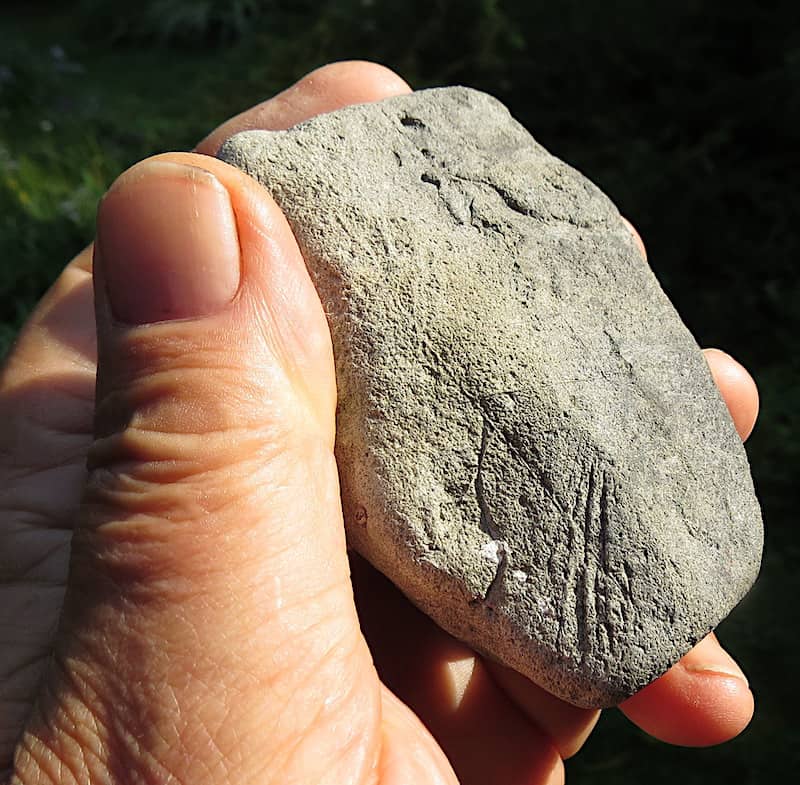
If anything, this specimen was even more rudimentary than Barry’s original find. We were all standing around, looking at the piece and marvelling at the weird coincidence of it all, when Aileen bent down and picked up a second rock (Fig. 20).
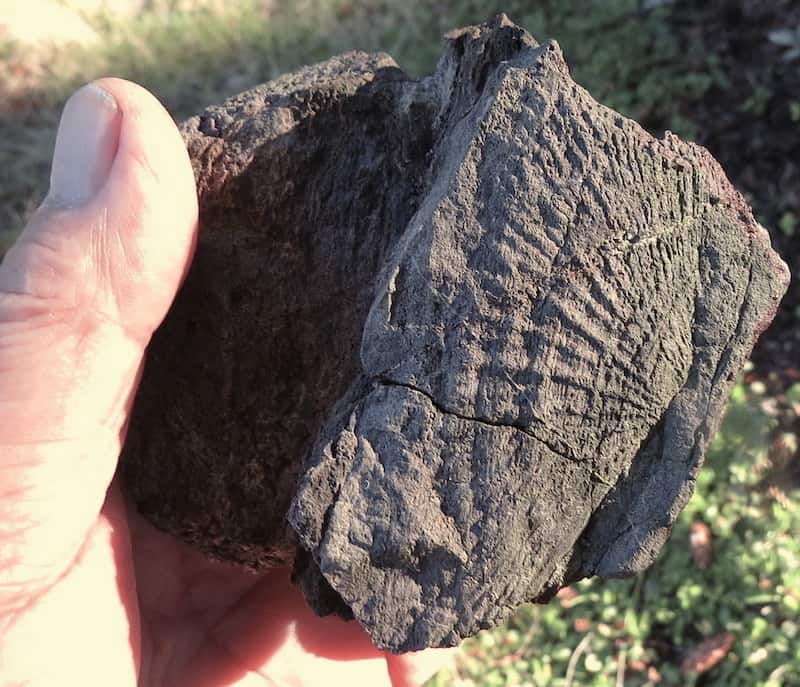
Everybody in our little party got very excited, and almost immediately Carrie found a couple of further specimens, followed by Barry’s find of a large chunk of rock with promising surface and cross-sectional markings. The latter invited the application of the geologist’s hammer, but I took the piece home to have greater control over the splitting process. The South Twin rocks, as mentioned before, are tectonically stressed and have many internal fractures that are not parallel to the bedding planes, nor do they necessarily follow the contours of the fossils themselves. (This is clearly visible in Fig. 20, with a prominent crack cutting across the specimen.)
Barry’s specimen turned out to be a lucky break (pun intended) and the fracture surface revealed a classic tableau of massed and densely stacked Monotis clams (Fig. 21).
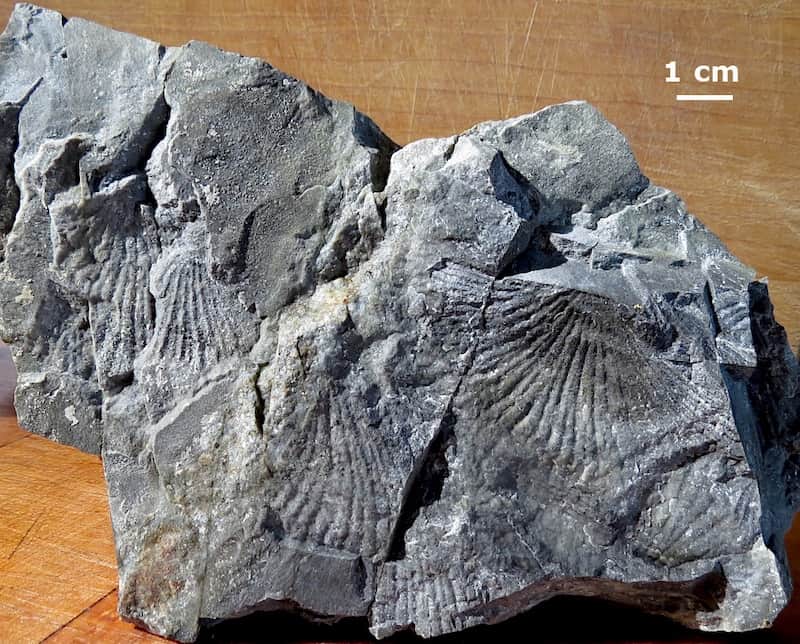
A brief subsequent visit to the location by Aileen and the author established the fact that the Monotis paper clams occur in bedrock strata (as opposed to only lose beach rocks), though the exposures we found were inconspicuous and not photogenic at all (Fig. 22).

It was the last location visit of the season (6 October 2020), when Barry finally found the solid and rich bedrock outcropping we all were looking for (Figs. 23 to 24).
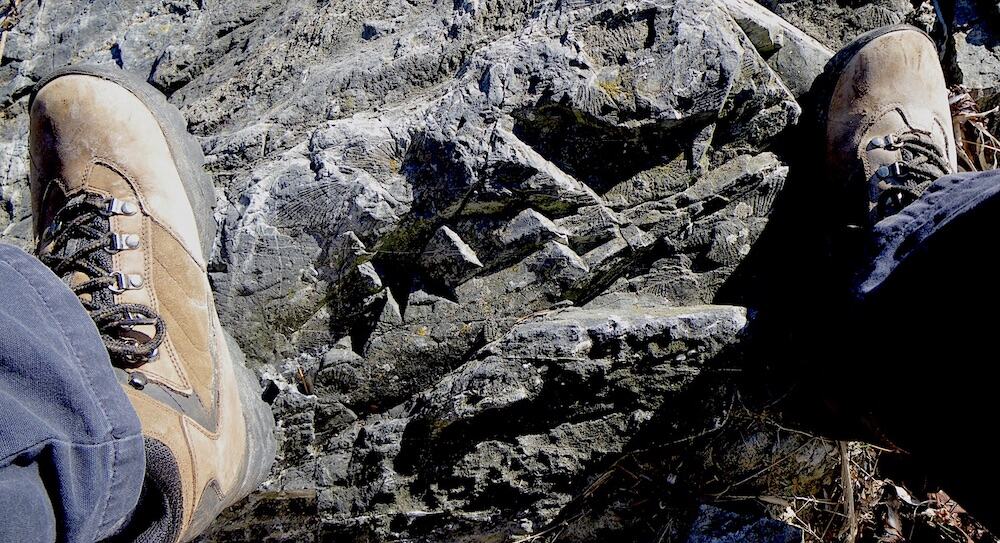
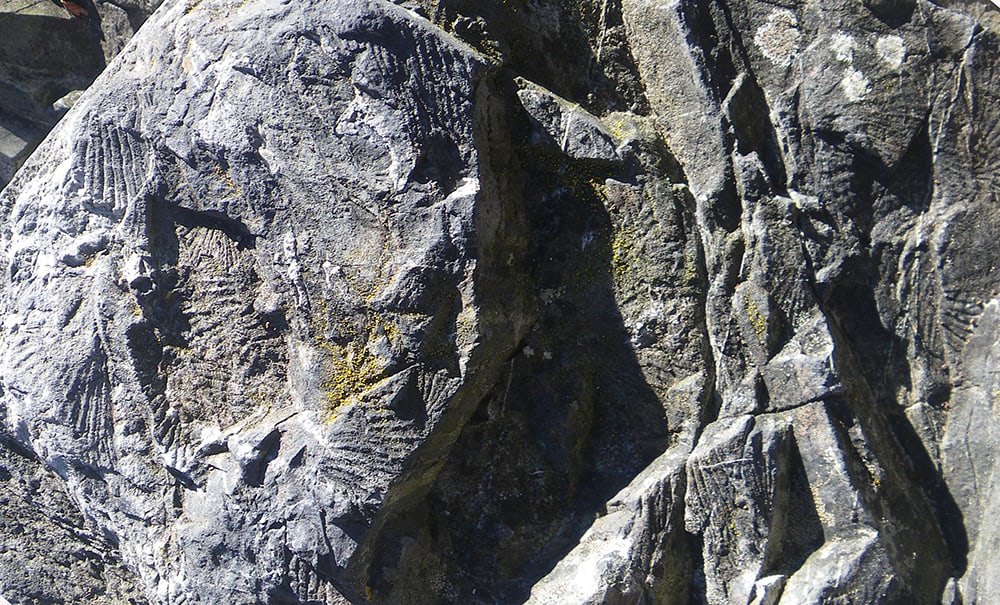
A successful field season had come to an end, with much future work on next year’s horizon. Some preparation work has been done since that last trip, especially on the material retrieved from the Cardita Bed (some of the results are documented by the photographs of previous pages).
Idocrase vs. Garnet
One final remark of some interest is correcting an earlier publication: Bancroft (1913) reported garnets from Echo Bay. It is our contention that he referred to crystals occurring in limestone layers near granitic intrusions, and that the mineral is in fact Idocrase (Fig. 25).
This low-grade metamorphic mineral, typical for contact zones between impure limestones and granite, is on first glance hard to distinguish from dull-brown iron-rich varieties of garnet. The appropriate diagnostics confirmed the identity of the mineral in question as Idocrase (Fig. 26).
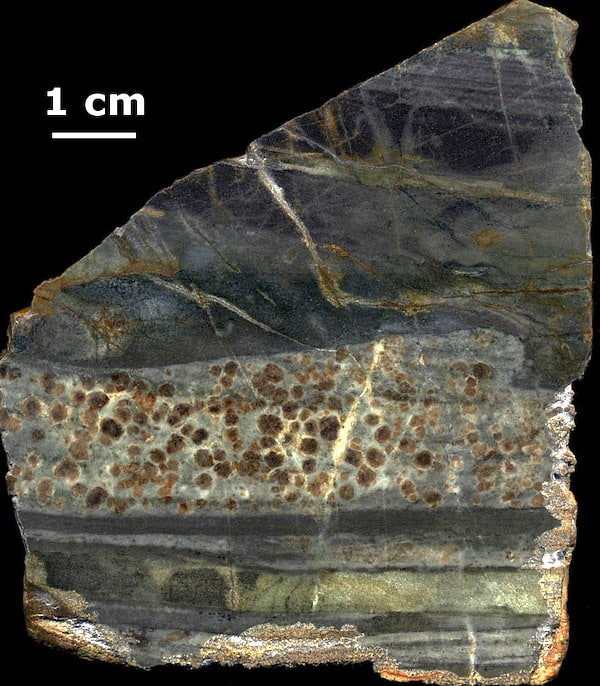
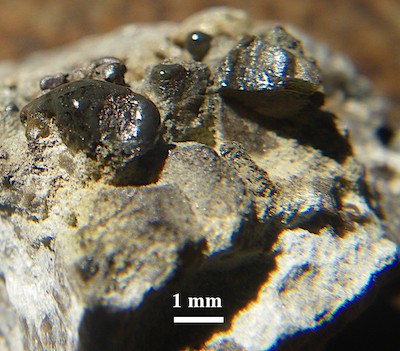
* * * * * *
A final “thank you” to the reader who persevered to the end of this blog. While trying not to get too technical, the writing of this account required a certain amount of precise terminology. It is hoped that the illustrations are of sufficient interest to carry the reader from page to page and that they leave a hint of the excitement the discovery of this diverse fossil fauna truly deserves.
More work is obviously required. The focus so far has been on Iron Point and the Echo Bay area. As the geological map at the very start of this write-up indicates, the entire east shore of the Twin Islands consists of Parson Bay Formation. Experience has shown that close scrutiny is required to discern the palaeontological treasures hidden in the rocks. Looking for a long time at just a few things can yield deeper insights than being distracted by multitudes of options and endlessly entertaining variety.
I am grateful for the collaboration and field-assistance of Barry and Carrie Saxifrage, and Aileen Douglas. — Christian Gronau

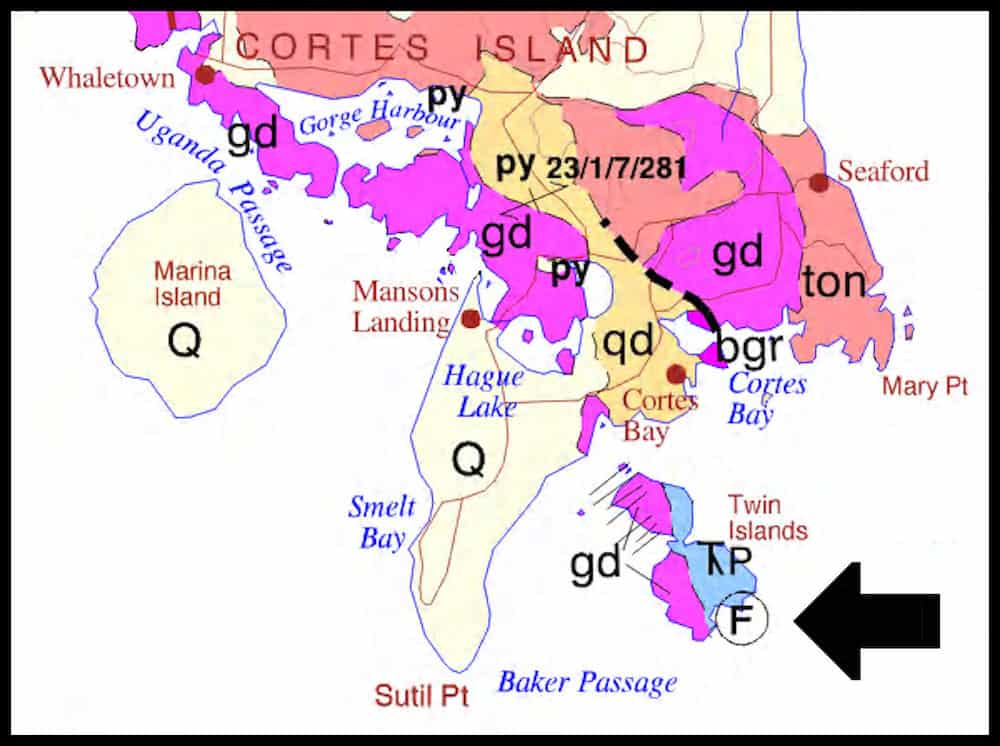


4 Responses
I persevered right to the end as your writing held the tension. The mystery revealed, the fossils revealed and all wonderfully close to home. Thanks Christian and all who worked to make this happen.
Thank you so much for posting this. I’ll have to check the bay out in the summer and see a bit of the past.
Fascinating!
Thanks Christian and fellow fossil finders!